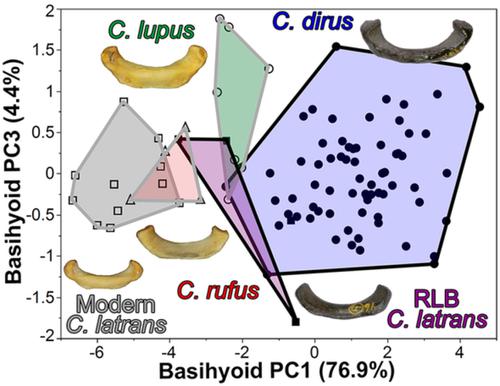当前位置:
X-MOL 学术
›
J. Morphol.
›
论文详情
Our official English website, www.x-mol.net, welcomes your feedback! (Note: you will need to create a separate account there.)
The howl of Rancho La Brea : Comparative anatomy of modern and fossil canid hyoid bones
Journal of Morphology ( IF 1.5 ) Pub Date : 2020-04-17 , DOI: 10.1002/jmor.21130 Deanna Flores 1, 2 , Emma I Eldridge 1 , Erin E Elminowski 1 , Edwin Dickinson 1 , Adam Hartstone-Rose 1
Journal of Morphology ( IF 1.5 ) Pub Date : 2020-04-17 , DOI: 10.1002/jmor.21130 Deanna Flores 1, 2 , Emma I Eldridge 1 , Erin E Elminowski 1 , Edwin Dickinson 1 , Adam Hartstone-Rose 1
Affiliation

|
The Rancho La Brea (RLB) fossil collection housed at the La Brea Tar Pits and Museum in Los Angeles, California, is one of the richest collections of carnivoran fossils in the world. The collection is also particularly well known for the preservation of rare and understudied bones in the tar, including the small bony apparatus that is of particular interest to this study, the hyoid. The La Brea collection houses hyoids from several extinct carnivoran species, some of the most common being those of Canis dirus (the dire wolf) and Canis latrans (the coyote). In this study, we compare fossilized hyoid elements from these two canids to samples from modern large congeners, namely: Canis lupus (the gray wolf), Canis rufus (the red wolf), and modern C. latrans. Seven or nine measurements were taken on each bone of the hyoid apparatus, and principal component analyses were performed in order to determine statistical significance between species. For most of the bones, the majority of the variation was driven by size. Dire wolves could be clearly differentiated from all other canids for all elements; the hyoid apparatus of C. dirus is larger and more robust than that of C. lupus. Most of the bony elements could not be distinguished between red wolves or modern coyotes. However, there are enough, complete fossil coyote basihyoids to compare with those of their modern relatives, and in several metrics (both PC shapes and overall size), RLB and modern C. latrans are significantly different. As larger hyoids have been associated with a lower vocal frequency, this distinction would have resulted in the vocalizations of C. dirus occurring at a lower frequency than those produced by C. lupus and perhaps lower vocalizations in ice age coyotes than their modern relatives.
中文翻译:

Rancho La Brea 的嚎叫:现代和化石犬舌骨的比较解剖学
位于加利福尼亚州洛杉矶的拉布雷亚焦油坑和博物馆的 Rancho La Brea (RLB) 化石收藏是世界上最丰富的食肉动物化石收藏之一。该藏品还以保存焦油中稀有和研究不足的骨骼而闻名,包括本研究特别感兴趣的小型骨器,即舌骨。La Brea 系列收藏了来自几种已灭绝食肉动物物种的舌骨,其中一些最常见的是 Canis dirus(恐狼)和 Canis latrans(土狼)。在这项研究中,我们将这两种犬科动物的舌骨化石元素与现代大型同源物的样本进行了比较,即:Canis lupus(灰狼)、Canis rufus(红狼)和现代 C. latrans。对舌骨装置的每块骨头进行了七九次测量,进行主成分分析以确定物种之间的统计显着性。对于大多数骨骼,大部分变化是由尺寸驱动的。恐狼在所有元素上都可以与所有其他犬科动物明显区分开来;C. dirus 的舌骨器官比 C. lupus 的更大、更坚固。大多数骨骼元素无法区分红狼或现代土狼。然而,有足够多的完整的土狼 basihyoids 化石可以与它们的现代亲属进行比较,并且在几个指标(PC 形状和整体大小)上,RLB 和现代 C. latrans 有显着差异。由于较大的舌骨与较低的发声频率相关,这种区别将导致 C. dirus 的发声频率低于 C. dirus 的发声频率。
更新日期:2020-04-17
中文翻译:

Rancho La Brea 的嚎叫:现代和化石犬舌骨的比较解剖学
位于加利福尼亚州洛杉矶的拉布雷亚焦油坑和博物馆的 Rancho La Brea (RLB) 化石收藏是世界上最丰富的食肉动物化石收藏之一。该藏品还以保存焦油中稀有和研究不足的骨骼而闻名,包括本研究特别感兴趣的小型骨器,即舌骨。La Brea 系列收藏了来自几种已灭绝食肉动物物种的舌骨,其中一些最常见的是 Canis dirus(恐狼)和 Canis latrans(土狼)。在这项研究中,我们将这两种犬科动物的舌骨化石元素与现代大型同源物的样本进行了比较,即:Canis lupus(灰狼)、Canis rufus(红狼)和现代 C. latrans。对舌骨装置的每块骨头进行了七九次测量,进行主成分分析以确定物种之间的统计显着性。对于大多数骨骼,大部分变化是由尺寸驱动的。恐狼在所有元素上都可以与所有其他犬科动物明显区分开来;C. dirus 的舌骨器官比 C. lupus 的更大、更坚固。大多数骨骼元素无法区分红狼或现代土狼。然而,有足够多的完整的土狼 basihyoids 化石可以与它们的现代亲属进行比较,并且在几个指标(PC 形状和整体大小)上,RLB 和现代 C. latrans 有显着差异。由于较大的舌骨与较低的发声频率相关,这种区别将导致 C. dirus 的发声频率低于 C. dirus 的发声频率。



























 京公网安备 11010802027423号
京公网安备 11010802027423号